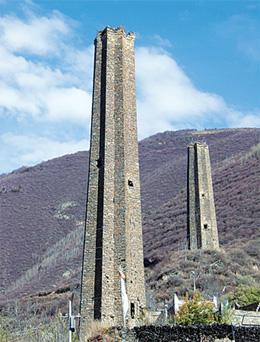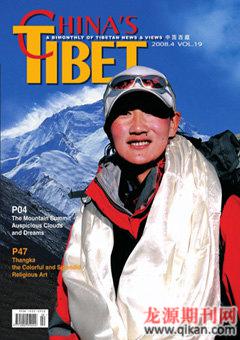Thangka-the Colorful and Splendid Religious Art

As I pass through, they lift their little heads, stare and then smile at me. Looking at them, their shy faces and small hands are daubed with colored inks, but their sparking eyes are always exceptionally clear and pierce deeply into my heart.
Teenagers from a Welfare School
In the cluster of buildings at the northern part of Lhasa City, a collective welfare vocational school, founded by a capable young girl from Fujian Province, is hidden down a long laneway. Inside the school over 80 disabled and poor teenagers (ranging from 10 to 18 years old) from all parts of the Tibet Autonomous Region (TAR) are studying Thangka painting. By inviting several famous Tibetan artists who specialized in the techniques of Thangka painting, embroidery, weaving, metal working and sculpture, the youthful founder has created an environment for these young disabled to gain skills and experience. Whenever I visit her, I have to pass through a 20sq. meter classroom on the first floor where over 20 children are studying Thangka painting.
The children here are asked, at the very least, to complete a six-year course. The Thangka apprentices, in most circumstance, are qualified to be teachers having successfully accomplished three years of study. That is, these persons have the essential knowledge to live off Thangka painting. However, to reach true proficiency another three-year study is still required.

The Varieties of Thangka
Thangka is a unique form of painting, a religious artwork that integrates Tibetan folklore with Buddhist religious culture. The framed Thangka resembles the scroll painting of Han Chinese. As well as the painted Thangkas in which the pictures are drawn on clothes, satins, and leather, Thangka also includes mounting Thangka, embroidery Thangka, and Thangka decorated with pearls. Nevertheless, all of the artworks feature a quality of intensity, delicate painting, exquisite lines and pictures, and spectacular colors.

With the embroidery Thangka, the pictures are embroidered using multiple colored silk threads, resembling the brocade of the hinterland, and the satin Thangkas use satin fabrics as the basic materials and then weave silk threads using jacquards. However, mounting Thangkas are created by systematically mounting colorful pieces of brocade to produce the exquisite pictures by cutting or gluing the pieces together. The most famous pearl Thangka, preserved in the Thandruk Monastery in Lhoka Prefecture, depicts the Bodhisattva of Compassion decorated with over 100 thousand precious pearls. Some Thangkas are produced by an integration of these different techniques. For instance, on colorful motifs artists may emboss them with pearls or diamonds or sew with gilt threads in order to make them look spectacular.
The woven Thangkas in Tibet are actually derived from the hinterland, in particular during the periods of Yongle and Chenghua in the Ming Dynasty. From the experience of woven Thangkas, Tibetans developed their embroidered Thangkas and mounted Thangkas, of which the most outstanding are preserved in Kumbum Monastery in Qinghai Province.
Printed Thangkas are also popular in Tibet. There are two ways to produce them; one is printed on papers with color and then framed, the other way is to carve the image on wood block, apply colored ink, then press the engraved picture onto a piece of thin cloth and frame the resultant image.
History of Tibetan Thangka
In legend the first Thangka was the portrait of Bailamo (a divinity) drawn by King Songtsen Gampo by using his nasal blood at the command of a divinity. Later, this Thangka was hidden in the stomach of Bailamo. Scholars believe that Thangka was actually brought into Tibet with the dissemination of Buddhism around the 7th Century. The earliest printed art of Tibet was of the Neolithic period but in the Tubo Kingdom it developed to perfection. Thangka is actually an artistic expression derived from Tibetan murals. It emerged before the mid 7th Century when varieties of Buddhist portraits were pervasive all over Tibet. By the 12th to 13th Century, the development of the Tibetan style of Buddhist portraits had reached mature form and gave Thangka its traditional appearance.
However, the earliest Thangkas were
destroyed and left no vestige remains due to the campaign against Buddhism launched by Lang Darma. Amongst currently preserved Thangkas, only a few masterpieces are left from the Song and Yuan dynasties, and the majority, by far, are from the period of the fifth Dalai Lama Lozang Gyatso. It was in this period that the fifth Dalai Lama ended the previous practice of individual production, only producing Thangkas as offerings to divinities, and gradually built institutions for Thangka painting, like painting studios, to raise the proficiency and volume of Thangka painting to the level of a national institution. In the time of the 7th Dalai Lama, some official institutions of Thangka production were formally launched to further support the long-term development of Thangka painting. Thereafter, Thangka painting formed into different painting schools.
The most substantial painting school was Mian Thang. At the end of the 14th Century, painter Manlha Dondrup Gyatso established the Mian Thang painting school, and wrote a monograph-The Ruyi Treasury of Painting Rules and Techniques -which was acknowledged by his descendants as the classic work on Tibetan painting. In his book, he standardized the measures and rules for painting in terms of defining the proportions, gestures and costumes of portrayed Buddhists. Tibetan artists adopted these measures as their universal rules, and all kinds of Buddhist painting and sculpture had to follow them.
Tibetans divide Thangka painting schools into four categories: the painting of U¨ (anterior Tibet, namely Lhasa region), the painting of Tsang (posterior Tibet, namely Shigatse region), the painting of Xikhang(Garma Garzhi in Tibetan Language), and the Han style Thangka painting. The first two kinds are the apprentices of Mian Thang. Often, the painting styles of anterior Tibet stresses much more on the deliberative design of a picture and is good at the depiction of the inner ethos of the figures represented, while the painting style of posterior Tibet is more likely to attach importance to refined drawing and a heavy emphasis on color. However, the Han style of Thangka painting, just as its name implies, is a painting style that draws its influences from the hinterland through absorbing and applying the Chinese national painting style. Interestingly, Xikhang painting style not only inherits the Mian Thang technique, but also integrates the painting features of the Han style of Thangka painting, and then forms its specific characteristics by focusing on layout and harmonious design while deliberately choosing elegant colors.
The Standardized Measures of Thangka Painting
Tibetans regard Thangka as a holy symbol. Therefore, Tibetans perceive the receiving of Thangka as a solemn ceremonial ritual. They regard Thangka painting as a pious procedure in which normal painting measures and rules must be applied and painters have to draw the Buddhist portraits strictly to correspond with the religious traditions that are buried deep in the hearts of the populace. Accordantly, the traditional Thangka painters who are enriched by long experience and the history unify the measures for portraying Buddha and Bodhisattvas, in terms of being quantifiable and standardized. Since the beginning of the 13th Century a succession of monographs, regarding the configuration and proportions of regional figures, have been written by artists - including Buddhist Sutra on the Configuration and Measures of Buddha and The Intellectual Headspring on Painting and Sculpting Holy Figures. In order to complete Buddhas portraits, artists are asked to follow all illustrated features of Buddha written in Buddhist sutras.
Thereafter, Thangka painters have their unified measures and rules to consult while painting their Thangka. When painting, Thangka artists always first prepare the outline to sketch out the proposed portraits of Buddha according to the unified standard measures dictating the size of all parts of painted figures, such as the head, chest, hand, waist, and feet. These must all follow the correct proportions. Based on this foundation, artists then extend their imagination and aesthetics to vary the portrayed pictures to finally produce their own individual style of Thangka painting.
Activities before Painting Thangka
As mentioned above, Tibetans view painting Thangka as a ceremonial ritual. In painting schools, students are asked to learn sutra recitation as well as studying painting skills. Usually the different portraits of Buddha that they are going to produce require them to recite Buddhist sutras. According to Tibetan traditional culture, Thangka painting often follows very strict and complicated rituals.
In line with Tibetan tradition, anyone attempting to make a Thangka as the obligation of his or her family must first invite a Rinpoche or an eminent Lama of Tibetan Buddhism to conduct an augury ceremony according to his or her birthday and eight birth characters in order to decide which Buddha or bodhisattvas to worship. Only after having determined the suitable choice after the augury, he or she then asks Thangka painters to portray the Buddha or Bodhisattvas for him or her.
In addition, the painting procedure always follows religious rituals without deviation. Therefore, in former times, a good Thangka painter often shows not only painting skills and expertise but also loyalty and devotion toward Buddha and Bodhisattvas through his sutra recitation, offering sacrifice and giving alms. One of the core rituals is to invite a religious instructor to conduct a meditation in order to invite the Wisdom of Buddha to unite with the physical body of painters so that they could successfully accomplish the whole painting. If the drawn pictures are the portraits of core Buddha or warriors of esoteric Buddhism, more comprehensive rituals are required before actually painting.
- Tibet的其它文章
- The Mountain Summit Auspicious Clouds and Dreams—Recapping the Moment of the Olympic Torch Relay Leg
- The Fraternal Bond between Ethnic Tibetans and the Victims of the Wenchuan Earthquake
- The Train Carries Love from the Sunlit City to the Victims
- Paljor Lhunpo Today
- Tsakhalho:Salt Production and the Preservation of a Church
- Trees in Lhasa

